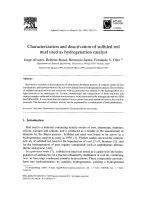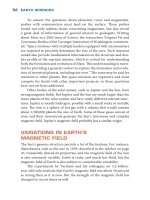Biodegradable Polyurethanes and Poly(ester amide)s
Bạn đang xem bản rút gọn của tài liệu. Xem và tải ngay bản đầy đủ của tài liệu tại đây (199.77 KB, 22 trang )
133
Biodegradable Polyurethanes and Poly(ester amide)s
Alfonso Rodr í guez - Gal á n , Lourdes Franco , and Jordi Puiggal í
Abbreviations
BDI 1,4 - buthylenediisocyanate
BDO 1,4 - butanediol
DSC differential scanning calorimetry
DMSO dimethyl sulfoxide
DMPA dimethylol propionic acid
DUD diurethanediol
DMTA dynamic mechanical thermal analysis
EM electron microscopy
ED ethylene diamine
H12MDI dicyclohexylmethane diisocyanate
HS hard segment
HDI 1,6 - hexamethylene diisocyanate
IR infrared spectroscopy
IPDI isophorone diisocyanate
LDI lysin methyl ester diisocyanate
MDI diphenylmethane diisocyanate
NMR nuclear magnetic resonance
PCL polycaprolactone
PCUs polycarbonate - based polyurethanes
PDA propanediamine
PDMO poly(decamethylene glycol)
PEAs poly(ester amide)s
PEEA poly(ether ester amide)
PEO poly(ethylene glycol)
PEUs polyester - based polyurethanes
PHMO poly(hexamethylene glycol)
POMO poly(octamethylene glycol)
PTMO polytetramethylene oxide glycol
PURs polyurethanes
SAXS small - angle X - ray scattering
Handbook of Biodegradable Polymers: Synthesis, Characterization and Applications, First Edition. Edited by
Andreas Lendlein, Adam Sisson.
© 2011 Wiley-VCH Verlag GmbH & Co. KGaA. Published 2011 by Wiley-VCH Verlag GmbH & Co. KGaA.
6
134
6 Biodegradable Polyurethanes and Poly(ester amide)s
TMDI trimethylhexamethylene diisocyanate
WAXD wide - angle X - ray diffraction
6.1
Chemistry and Properties of Biodegradable Polyurethanes
Polyurethane s ( PUR s) were fi rst used for industrial applications in the 1940s, but
the development of biocompatible polymers did not start until the 1960s. PURs
have since then remained one of the most popular groups of biomaterials employed
in medical devices. Toughness, durability, biocompatibility, and biostability are
some of the characteristics that make PURs interesting for a wide variety of
long - term implantable devices. However, the number of applications requiring
biodegradability instead of biostability is on the rise, and consequently also the
demand for new PURs with a controlled degradation rate.
Biodegradable PURs employed as thermoplastics are basically synthesized using
a diisocyanate, a diol, and a chain - extension agent as main raw components [1, 2]
(Tables 6.1 – 6.3 , Figure 6.1 ). Although both aromatic and aliphatic diisocyanates
have an applied interest, it should be pointed out that the putative carcinogenic
nature of aromatic compounds [3, 4] is leading to an increasing use of HDI, BDI,
and LDI, whose ultimate degradation products are more likely to be nontoxic (e.g.,
lysine).
The diol component commonly chosen is a low - molecular - weight polymer with
hydroxyl end groups and a backbone that, in the case of biodegradable PURs, may
correspond to a polyether, polyester, or polycarbonate [5] . The fi rst gave rise to the
Table 6.1
Diisocyanate raw materials.
OCN – CH
2
CH
2
CH
2
CH
2
CH
2
CH
2
– NCO
1,6 - Hexamethylene diisocyanate (HDI)
Lysine methyl ester diisocyanate (LDI)
OCN – CH
2
CH
2
CH
2
CH
2
– NCO
1,4 - Butylenediisocyanate (BDI)
Isophorone diisocyanate (IPDI)
trans - 1,4 - Cyclohexylene diisocyanate
2,2,4 - Trimethylhexamethylene
diisocyanate (TMDI)
Dicyclohexylmethane diisocyanate (H12MDI)
6.1 Chemistry and Properties of Biodegradable Polyurethanes
135
Table 6.3
Chain extender raw materials.
Diols Diamines
Ethylene glycol
HOCH
2
CH
2
OH
Ethylene diamine
(ED)
H
2
NCH
2
CH
2
NH
2
1,4 - Butanediol (BDO)
HOCH
2
CH
2
CH
2
CH
2
OH
1,3 - Propanediamine
(1,3 - PDA)
H
2
NCH
2
CH
2
CH
2
NH
2
1,3 - Butanediol
1,2 - Propanediamine
(1,2 - PDA)
2,2 - Dimethyl - propanediol
1,4 - Butanediamine
H
2
NCH
2
CH
2
CH
2
CH
2
NH
2
HOCH
2
CH
2
OH
CH
2
O–OCCHNH
2
CH
2
PhPhCH
2
NH
2
CHCO–OCH
2
–
–
1,4 - Cyclohexanedimethanol
1,4 - Cyclohexanedimethanol - L - phenylalanine
diester
Table 6.2
Macrodiol raw materials.
Polyether - based
PURs
Polyesther - based
PURs
Poly(ethylene
glycol), PEO
HO[(CH
2
)
2
O]
n
H
Polyglycolide
HO[CH
2
COO]
n
– R – [OOCCH
2
]
m
OH
Poly(tetramethylene
glycol), PTMO
HO[(CH
2
)
4
O]
n
H
Poly(D,L - lactide)
Poly(hexamethylene
glycol), PHMO
HO[(CH
2
)
6
O]
n
H
Poly(
ε
-
caprolactone)
HO[(CH
2
)
5
COO]
n
– R – [OOC(CH
2
)
5
]
m
OH
HO[(CH
2
)
m
OOC(CH
2
)
4
COO]
n
H
Poly(octamethylene
glycol), POMO
HO[(CH
2
)
8
O]
n
H
Poly(decamethylene
glycol), PDMO
HO[(CH
2
)
10
O]
n
H
Poly(ethylene
adipate)
m = 2
Poly(propylene
adipate)
m = 3
Poly(butylene
adipate)
m = 4
136
6 Biodegradable Polyurethanes and Poly(ester amide)s
so - called polyether - based urethanes, which have been the most common so far.
Nevertheless, in recent years polyester - based PURs have begun to be developed
due to their increased biodegradability. Selected macrodiols are all viscous liquids
with a number average molecular weight ranging between 400 and 5000 g/mol.
Polyester diols can be prepared by ring - opening polymerization of a cyclic lactone
[6] or condensation between a dicarboxylic acid and an excess of a diol. In some
cases, the polyester diol, which is characterized by a hydrophobic character, is
mixed with the more hydrophilic polyethylene glycol ( PEG ) before performing the
reaction with the corresponding diisocyanate. This way, PURs with an increased
biodegradation rate and enhanced cell attachment can be obtained. Note that these
characteristics can be easily tailored by a simple change in the composition of the
mixture [7] .
The reaction between the diol and the diisocyanate is carried out with an excess
of the latter (keeping the isocyanate/hydroxyl molar ratio usually close to 2:1) in
order to obtain a reactive prepolymer with isocyanate end groups. Catalysts (typi-
cally tertiary amines, stannous octoate, or dibutyltin dilaurate) and high tempera-
tures (60 – 90 ° C) are required to increase the reaction rate. A thermoplastic PUR
material characterized by a segmented architecture is fi nally obtained by reaction
of the terminal isocyanate groups with a chain extender (Figure 6.1 ) which may
be either a diol or a diamine with low molecular weight [8] . In the fi rst case, ure-
thane bonds are formed and the fi nal polymer is usually thermally processable,
whereas in the second case new urea bonds are formed and the resulting
poly(urethane/urea) is usually only suitable for solvent casting.
Some secondary reactions, which generally result in branched or cross-
linked polymers, can also occur under certain conditions [9] . The most usual are
Figure 6.1
Schematic representation showing the two steps involved in the synthesis of
segmented polyurethanes.
6.1 Chemistry and Properties of Biodegradable Polyurethanes
137
(Scheme 6.1 ) (i) trimerization of isocyanate groups leading to isocyanurates, (ii)
formation of biuret linkages from urea groups, and (iii) formation of allophanate
units by reaction between an isocyanate group and the NH of a urethane group.
This last reaction may sometimes be of interest since mechanical properties can
be improved by a small number of crosslinking bonds. A great advantage is that
the allophanate formation reaction is thermally reversible, and so it is feasible to
obtain thermally processable materials.
From an industrial point of view, PUR synthesis can be performed in a single
step by mixing all reagents or following the above two - step methodology [8 – 10] .
In the fi rst case, bulk polymerization can be carried out by a single batch procedure
or by a semicontinuous process using reactive extruders or injection - molding
machines. The two - step procedure has two main advantages: (i) the polymer
architecture can be well controlled, and (ii) polymers with a heterogeneous com-
position, which are obtained when nonpolar macrodiols are involved, can be
avoided. This synthesis can be accomplished in bulk or in solvents (typically N , N -
dimethylacetamide and N , N - dimethylformamide) [11] although the latter option
is commercially less attractive.
The mechanical properties of segmented PURs are highly interesting due to the
microphase separation (Figure 6.2 a) of their two constitutive segments [12] : non-
polar soft segments and more polar hard segments derived from the diisocyanate
and the chain extender. The soft microdomain is amorphous and often has a glass
transition temperature lower than 0 ° C, resulting in rubber characteristics like
extensibility and softness. In contrast, hard segments can crystallize as a conse-
quence of the strong hydrogen - bond intermolecular interactions that can be estab-
lished between their urethane or urea groups. These ordered domains act as
physical crosslinks providing cohesive strength to the polymer matrix and allowing
the material to resist fl ow when stress is applied. Segmented PURs can be con-
sidered thermoplastic elastomers since physical crosslinks can be easily disrupted
by heating the polymer above the melting temperature of hard segment domains
or by dissolving the material in aprotic solvents like dimethylformamide.
Scheme 6.1
Characteristic secondary reactions observed in the synthesis of polyurethanes.
138
6 Biodegradable Polyurethanes and Poly(ester amide)s
Thermoset PURs can be prepared by inducing chemical crosslinks, either in the
hard segment or the soft segment, or both. The resulting material has greater
strength and durability, and worse phase separation. Crosslinking is achieved by
using intermediates with a functionality higher than two (e.g., trimethylolpropane,
glycerol, and 1,2,6 - hexanetriol) (Scheme 6.2 ). These networks can have rigid or
fl exible characteristics, mainly depending on the density of chemical crosslinks,
and may give rise to biodegradable foams useful for many applications such as
scaffolds [13 – 15] . In fact, the reaction of water with an isocyanate group leads to
the formation of carbon dioxide gas, which can be used as a blowing agent in the
creation of pores.
Several factors must be considered when designing PUR materials with targeted
properties [16] : (i) harder and stiffer polymers with higher tear strength and lower
elongation at break can be prepared by increasing the chain extender to diol ratio
and/or decreasing the molecular weight of the macrodiol unit; (ii) diamine chain
extenders lead to hard segments with higher melting temperature and harder
mechanical properties; (iii) aromatic diisocyanates increase chain stiffness and
facilitate aggregation of the hard phase by π - electron association; and (iv) variation
in the number of substitutions and spacing between and within branch chains
affects the fl exibility of molecular chains. The knowledge of the hard segment
content is thus an easy way to predict mechanical properties of PURs: soft material
(HS < 15 wt%), rubbery elastomer (15 wt% < H S < 40 wt%), tough elastomer
(40% < H S < 65 wt%), and strong engineering polymer (HS > 65 wt%) [17] .
Figure 6.2
Representation of the characteris-
tic microphase separation in a segmented
polyurethane (a) and the infl uence of
stretching into orientation and crystallization
of microdomains (b, c). Moderate (b) and
high extension (c) are represented. The thick
strokes represent hard segments and the thin
strokes soft segments.
6.1 Chemistry and Properties of Biodegradable Polyurethanes
139
Indeed, understanding the morphology is crucial for the design of materials
with specifi c properties. Molecular organization of PURs has been investigated by
several techniques, including differential scanning calorimetry ( DSC ), wide - angle
X - ray diffraction ( WAXD ), small - angle X - ray scattering ( SAXS ), infrared spectros-
copy (IR), electron microscopy ( EM ), dynamic mechanical thermal analysis
( DMTA ), and nuclear magnetic resonance ( NMR ) [18] .
DSC experiments show that PURs have several thermal transitions, the inter-
pretation of which is rather complex [19] . Glass transitions of both hard and soft
amorphous microphases can be detected. The T
g
value of the soft domain, which
appears at the lowest temperature, may be used to evaluate the number of hard
segments in this domain since T
g
should increase when the degree of mixing is
raised. However, a quantitative analysis is problematic due to the infl uence of
factors like restrictions on the motion of soft segments caused by the presence of
microcrystals. In addition, DSC traces can show multiple endothermic peaks
which may be ascribed to morphological effects and be broadly divided into loss
of long - and short - range order.
Early explanations about these multiple endotherms were based on the disrup-
tion of different kinds of hydrogen - bonding interactions [20, 21] . However, infra-
red thermal analysis led to discarding a clear relationship between endothermic
peaks and these interactions [22] . Hydrogen bonding plays a signifi cant role in the
design of biostable or biodegradable materials as it is a determinant factor of their
hydrolytic stability. Susceptibility to hydrolytic degradation is clearly enhanced
when the carbonyl groups in the hydrolyzable group do not act as hydrogen - bond
acceptors. The knowledge of hydrogen - bond distribution in PUR materials is thus
essential to obtain materials with a specifi c degradation rate.
Scheme 6.2
Synthesis of PURs ’ networks and reaction conducing to CO
2
as blowing agent.
140
6 Biodegradable Polyurethanes and Poly(ester amide)s
Molecular ordering crystallization may be favored by subjecting a PUR chain to
stress [23] . Thus, at a moderate extension (e.g., 250%) macrodiols of the soft
segment become partially aligned and crystallized. When the extension is increased,
further crystallization occurs and hard segments turn into the direction of elonga-
tion and form paracrystalline layer lattice crystals (Figure 6.2 ).
6.2
Biodegradation Mechanisms of Polyurethanes
Susceptibility of PURs to biodegradation is an inherent feature of their chemistry
[24, 25] . It was detected by the industrial manufacturing community before sys-
tematic biodegradation studies were conducted in the 1980s. In fact, degradation
of PURs may initiate during fabrication due to high temperatures, the presence
of liquids, and the diffi culty to completely remove moisture from the reaction
mixture [26] .
Microorganisms can be easily grown in appropriate cellular media following
well - established technologies that allow using enzymes segregated outside cells,
even in industrial applications. Biodegradation is governed by organism type,
polymer characteristics, and the pretreatment performed on the sample. During
degradation, the polymer is fi rst converted into its monomers, which should then
be mineralized. It is clear that polymers are too large to pass through cell mem-
branes, so they must fi rst be depolymerized into smaller compounds which may
then be absorbed and biodegraded within microbial cells [27] (Figure 6.3 ). Com-
plete mineralization can thus be achieved, the end products being biomass, CO
2
,
and water when aerobic microorganisms are involved, plus CH
4
when anaerobic
Figure 6.3
Proposed model for the degradation of PURs by the action of a cell - associated
enzyme and extracellular enzymes.









